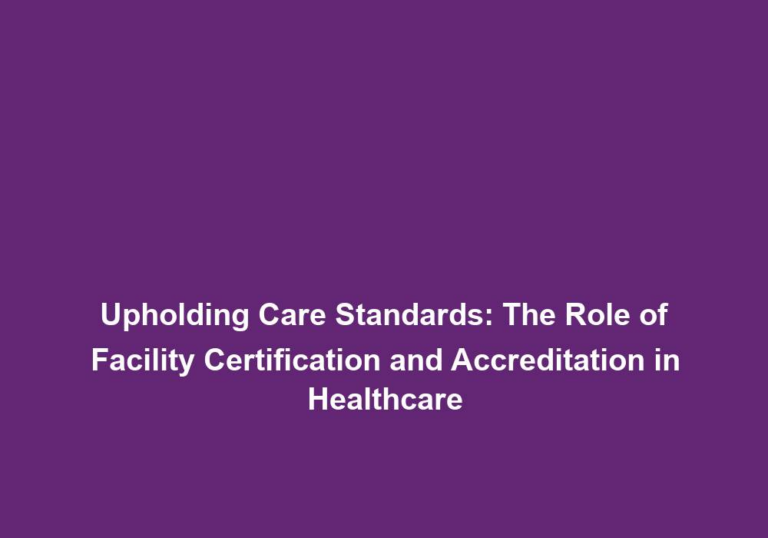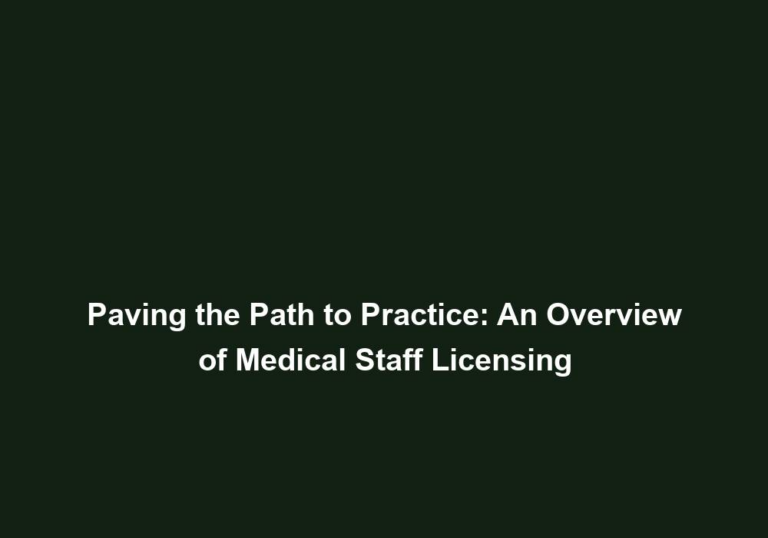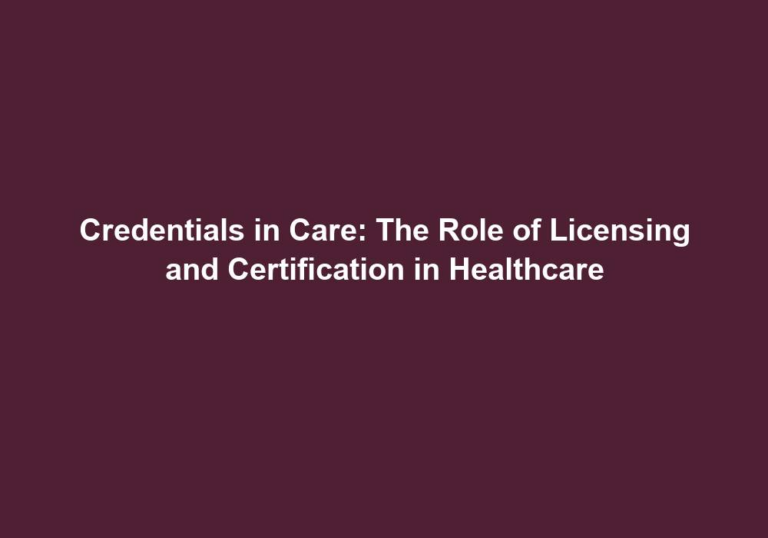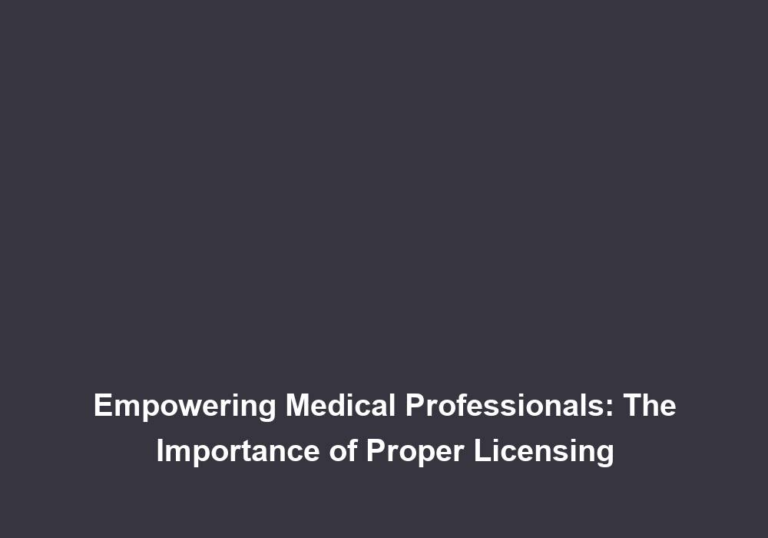Ensuring Excellence: The Process of Facility Certification and Accreditation
In today’s competitive business landscape, organizations across various industries strive to achieve excellence in their operations. One crucial aspect of this pursuit is obtaining facility certification and accreditation. These credentials not only validate an organization’s commitment to quality but also provide a strong foundation for success. In this article, we will explore the process of facility certification and accreditation, highlighting its significance and the steps involved.
Understanding Facility Certification and Accreditation
Facility certification and accreditation are two distinct but closely related processes that aim to ensure that a facility meets specific standards and requirements. While the terms are often used interchangeably, there are slight differences between the two.
Facility Certification:
Facility certification refers to the process of verifying that a facility complies with specific industry standards, regulations, or best practices. It typically involves an assessment conducted by a certified third-party organization. The certification process evaluates various aspects of the facility, including its operations, infrastructure, health and safety measures, and environmental impact.
Achieving facility certification demonstrates an organization’s commitment to providing high-quality products or services while adhering to industry-specific guidelines. It also enhances the organization’s reputation, instills customer confidence, and may even open doors to new business opportunities.
Facility Accreditation:
Facility accreditation, on the other hand, involves a more comprehensive evaluation than certification. Accreditation is typically granted by an independent accrediting body or association that specializes in a particular industry or sector. It serves as a formal recognition that a facility has met specific standards of excellence, surpassing basic certification requirements.
Accreditation signifies that a facility has gone above and beyond the minimum requirements and has implemented best practices in its operations. It often involves a rigorous evaluation process, including self-assessment, on-site inspections, and a review of the facility’s policies, procedures, and performance indicators.
Benefits of Facility Certification and Accreditation
Obtaining facility certification and accreditation offers numerous benefits to organizations seeking to excel in their respective industries. Some of the key advantages include:
-
Enhanced Reputation and Credibility: Facility certification and accreditation demonstrate that an organization is dedicated to maintaining high standards of quality, safety, and professionalism. This, in turn, enhances its reputation and credibility among customers, partners, and stakeholders. It assures stakeholders that the organization is committed to delivering excellence.
-
Competitive Advantage: Certification and accreditation provide a competitive edge by differentiating an organization from its competitors. They serve as powerful marketing tools that showcase an organization’s commitment to excellence, helping to attract new customers and retain existing ones. Additionally, many clients and customers specifically seek certified or accredited facilities, giving certified organizations a distinct advantage in winning contracts and projects.
-
Improved Operational Efficiency: The certification and accreditation process often involves a comprehensive review of a facility’s operations, policies, and procedures. This evaluation helps identify areas for improvement, leading to increased operational efficiency and effectiveness. By implementing best practices and addressing deficiencies, organizations can streamline their processes and optimize resource utilization.
-
Increased Employee Morale and Engagement: Achieving facility certification and accreditation requires the active participation of employees at all levels. The process encourages teamwork, fosters a culture of continuous improvement, and boosts employee morale and engagement. When employees see the organization’s dedication to meeting high standards, they feel a sense of pride and motivation in their work.
-
Access to New Business Opportunities: Many clients, customers, and government agencies require certified or accredited facilities for certain projects or contracts. By obtaining these credentials, organizations gain access to new business opportunities that may otherwise be unavailable. Certification and accreditation serve as proof of competence and reliability, making organizations more attractive to potential clients and partners.
The Process of Facility Certification and Accreditation
While the specific steps involved in facility certification and accreditation may vary depending on the industry and standards being pursued, there are some common stages in the process. Here is a general outline of the steps typically involved:
1. Pre-Assessment:
Before pursuing certification or accreditation, it is essential to conduct an internal assessment to determine the facility’s readiness. This involves reviewing current practices, policies, and procedures against the desired standards or requirements. The pre-assessment helps identify any gaps or areas that need improvement before moving forward with the certification process.
2. Gap Analysis:
After the pre-assessment, a gap analysis is performed to identify areas where the facility falls short of the standards. This analysis helps highlight deficiencies and provides a roadmap for necessary improvements. It involves comparing the current state of the facility against the desired state outlined in the certification or accreditation requirements.
3. Implementation of Corrective Measures:
Based on the gap analysis, the organization implements corrective measures to address the identified deficiencies. This may involve updating policies, improving infrastructure, training employees, or implementing new procedures. The goal is to bridge the gaps and align the facility’s practices with the required standards.
4. Application and Documentation:
Once the necessary improvements are made, the organization submits an application for certification or accreditation. This application typically includes detailed documentation of the facility’s compliance with the standards, along with supporting evidence. It is crucial to provide comprehensive and accurate information to demonstrate the facility’s adherence to the required criteria.
5. On-Site Evaluation:
In many cases, the certification or accreditation process involves an on-site evaluation by a team of experts from the certifying or accrediting body. This evaluation assesses the facility’s operations, verifies the provided documentation, and ensures compliance with the required standards. The team may conduct interviews, inspect facilities, and review records to validate the information provided in the application.
6. Review and Decision:
After the on-site evaluation, the certifying or accrediting body reviews all the collected information, including the application, documentation, and on-site evaluation results. Based on this review, a decision is made regarding the facility’s certification or accreditation status. The review process ensures that all requirements have been met and that the facility meets the necessary standards for certification or accreditation.
7. Ongoing Compliance and Maintenance:
Obtaining certification or accreditation is not a one-time achievement. Facilities need to maintain ongoing compliance with the standards by regularly monitoring their operations, conducting internal audits, and implementing corrective actions when necessary. Periodic reassessments or renewals may also be required depending on the accrediting body’s policies. This ensures that the facility continues to meet the standards and upholds its certified or accredited status.
Conclusion
Facility certification and accreditation are vital processes that organizations undertake to ensure excellence in their operations. These credentials not only validate an organization’s commitment to quality, safety, and professionalism but also provide various benefits including enhanced reputation, competitive advantage, and access to new business opportunities. By following a well-defined process and continuously striving for improvement, organizations can achieve and maintain these valuable credentials, setting themselves apart in today’s highly competitive business landscape.
This article is written by a SEO content writing expert who specializes in delivering high-quality content in fluent English.







